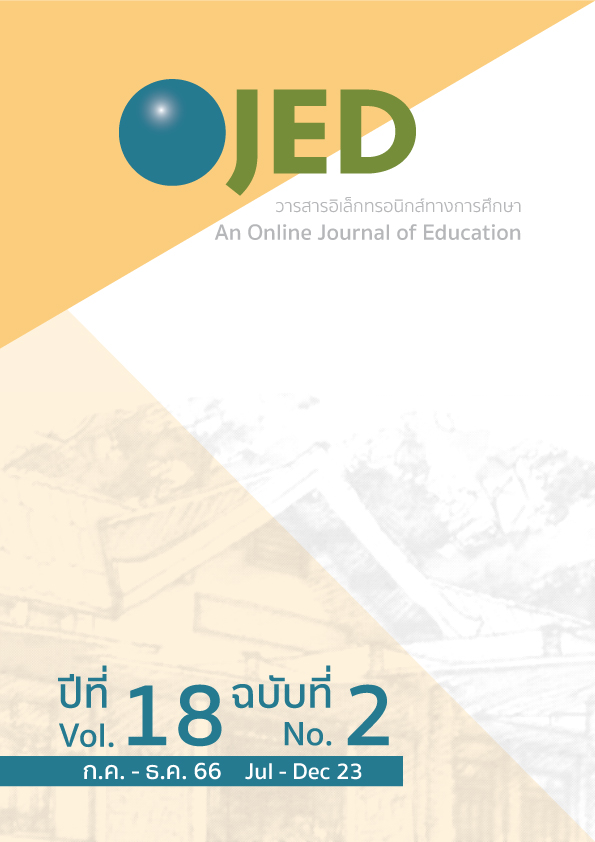Enhancing English Writing Ability in Chinese Lower-Secondary Students through Indirect Corrective Feedback and Metalinguistic Corrective Feedback.
DOI:
https://doi.org/10.14456/ojed.2023.24Keywords:
written corrective feedback, indirect corrective feedback, metalinguistic corrective feedback, writing abilityAbstract
This study primarily aims to examine the distinct effects of indirect and metalinguistic corrective feedback on the English writing abilities of lower-secondary Chinese students. Additionally, the study seeks to explore students' viewpoints regarding these two types of feedback, focusing on their preferences and comprehension of feedback mechanisms. The participants included 30 Grade 8 students from a public school in Rizhao City, Shandong Province, China. The instruments for collecting data included a pre-test, a post-test, and interview questions. The quantitative results of the two-way repeated-measures ANOVA revealed that the difference between the two types of feedback is insignificant. The interview results revealed that students preferred metalinguistic corrective feedback because it was easier to understand. The research highlights the value of providing different types of corrective feedback to students. Teachers can tailor their feedback based on individual student needs and preferences.
References
Abdulloh, A. (2021, March 30). The Students’ Perception towards Code-Switching and Code-Mixing in Sociolinguistic: A Case at an English Education Major. EDULINK EDUCATION AND LINGUISTICS KNOWLEDGE JOURNAL, 3(1), 24. https://doi.org/10.32503/edulink.v3i1.1476
Bitchener, J. (2008). Evidence in support of written corrective feedback. Journal of Second Language Writing, 17(2), 102–118. https://doi.org/10.1016/j.jslw.2007.11.004
Bitchener, J., & Ferris, D. R. (2012). Written Corrective Feedback in Second Language Acquisition and Writing. Taylor & Francis.
Bitchener, J., & Knoch, U. (2009). The contribution of written corrective feedback to language Development: a ten month investigation. Applied Linguistics, 31(2), 193–214. https://doi.org/10.1093/applin/amp016
Bitchener, J., Young, S., & Cameron, D. (2005). The effect of different types of corrective feedback on ESL student writing. Journal of Second Language Writing, 14(3), 191–205. https://doi.org/10.1016/j.jslw.2005.08.001
Brown, H. D. (2001). Teaching by Principles: An Interactive Approach to Language Pedagogy. TESOL Quarterly, 35(2), 341. https://doi.org/10.2307/3587655
Chandler, J. (2003, August). The efficacy of various kinds of error feedback for improvement in the accuracy and fluency of L2 student writing. Journal of Second Language Writing, 12(3), 267–296. https://doi.org/10.1016/s1060-3743(03)00038-9
Chen, S., Nassaji, H., & Qian, L. (2016). EFL learners’ perceptions and preferences of written corrective feedback: a case study of university students from Mainland China. Asian-Pacific Journal of Second and Foreign Language Education, 1(1). https://doi.org/10.1186/s40862-016-0010-y
Ellis, R. (1999). Learning a Second Language through Interaction. In Studies in bilingualism. John Benjamins Publishing Company. https://doi.org/10.1075/sibil.17
Ellis, R. (2008, May 23). A typology of written corrective feedback types. ELT Journal, 63(2), 97–107. https://doi.org/10.1093/elt/ccn023
Ene, E., & Upton, T. A. (2018, September). Synchronous and asynchronous teacher electronic feedback and learner uptake in ESL composition. Journal of Second Language Writing, 41, 1–13. https://doi.org/10.1016/j.jslw.2018.05.005
Ferris, D. (1999, January). The case for grammar correction in L2 writing classes: A response to truscott (1996). Journal of Second Language Writing, 8(1), 1–11. https://doi.org/10.1016/s1060-3743(99)80110-6
Ferris, D. R. (2004, March). The “Grammar Correction” Debate in L2 Writing: Where are we, and where do we go from here? (and what do we do in the meantime . . .?). Journal of Second Language Writing, 13(1), 49–62. https://doi.org/10.1016/j.jslw.2004.04.005
Ferris, D., & Roberts, B. (2001, August). Error feedback in L2 writing classes. Journal of Second Language Writing, 10(3), 161–184. https://doi.org/10.1016/s1060-3743(01)00039-x
Hong, Y. & Utah: Depeatment of Linguistics and English language Brigham Young University. (2004).
The Effect of Teachers’ Error Feedback on International Students’ Self-Correction Ability.
Online Master Thesis. https://scholarsarchive.byu.edu/cgi/viewcontent.cgi?article=1182&context=etd
Knoch, U. (2008, July). The value of written corrective feedback for migrant and international students. Language Teaching Research, 12(3), 409–431. https://doi.org/10.1177/
Lee, I. (2005, May 1). Error Correction in the L2 Writing Classroom: What Do Students Think? TESL Canada Journal, 22(2), 1. https://doi.org/10.18806/tesl.v22i2.84
Li, H., & He, Q. (2017, February 6). Chinese Secondary EFL Learners’ and Teachers’ Preferences for Types of Written Corrective Feedback. English Language Teaching, 10(3), 63.
https://doi.org/10.5539/elt.v10n3p63
Makino, T. (1993). Learner self-correction in EFL written compositions. ELT Journal, 47(4), 337– 3341. https://doi.org/10.1093/elt/47.4.337
Mao, Z., & Lee, I. (2021, September 8). Researching L2 Student Engagement with Written Feedback: Insights from Sociocultural Theory. TESOL Quarterly, 56(2), 788–798. https://doi.org/
1002/tesq.3071
Nunan, D. (1991). Communicative Tasks and the Language Curriculum. TESOL Quarterly, 25(2), 279. https://doi.org/10.2307/3587464
RÉVÉSZ, A. (2015, June). Direct Written Corrective Feedback, Learner Differences, and the Acquisition of Second Language Article Use for Generic and Specific Plural Reference. The Modern Language Journal, 99(2), 263–282. https://doi.org/10.1111/modl.12212
Saragih, N. A., Madya, S., Siregar, R. A., & Saragih, W. (2021). Written Corrective Feedback: Students' Perception and Preferences. International Online Journal of Education and Teaching, 8(2), 676-690.
Saukah, A., Dewanti, D. S., & Laksmi, E. D. (2017). The effect of coded and non-coded correction feedback on the quality of Indonesian EFL students’ writing. Indonesian Journal of Applied Linguistics. https://doi.org/10.17509/ijal.v7i2.8127
SHEEN, Y. (2007, June). The Effect of Focused Written Corrective Feedback and Language Aptitude on ESL Learners’ Acquisition of Articles. TESOL Quarterly, 41(2), 255–283. https://doi.org/
1002/j.1545-7249.2007.tb00059.x
Truscott, J. (1996). The case against grammar correction in L2 writing classes. Language Learning,
, 327-369.
Truscott, J. (1999). The case for the case against grammar correction in L2 writing classes: A response to Ferris. Journal of Second Language Writing, 08:111-122.
Truscott, J. (2007). The effect of error correction on learners' ability to write accurately. Journal of Second Language Writing, 16: 255-272.
Van Beuningen, C., de Jong, N., & Kuiken, F. (2008). The Effect of Direct and Indirect Corrective Feedback on L2 Learners’ Written Accuracy. ITL - International Journal of Applied Linguistics, 156, 279–296. https://doi.org/10.2143/itl.156.0.2034439
Van Beuningen, C. G., De Jong, N. H., & Kuiken, F. (2011, October 14). Evidence on the Effectiveness of Comprehensive Error Correction in Second Language Writing. Language Learning, 62(1), 1–41. https://doi.org/10.1111/j.1467-9922.2011.00674.x
White, H., & Sabarwal, S. (2014). Quasi-experimental design and methods. Methodological briefs: impact evaluation, 8(2014), 1-16.
Zhang, T., Chen, X., Hu, J., & Ketwan, P. (2021). EFL Students’ Preferences for Written Corrective Feedback: Do Error Types, Language Proficiency, and Foreign Language Enjoyment Matter? Frontiers in Psychology, 12. https://doi.org/10.3389/fpsyg.2021.660564
Downloads
Published
How to Cite
Issue
Section
License
Copyright (c) 2023 An Online Journal of Education

This work is licensed under a Creative Commons Attribution-NonCommercial-NoDerivatives 4.0 International License.




